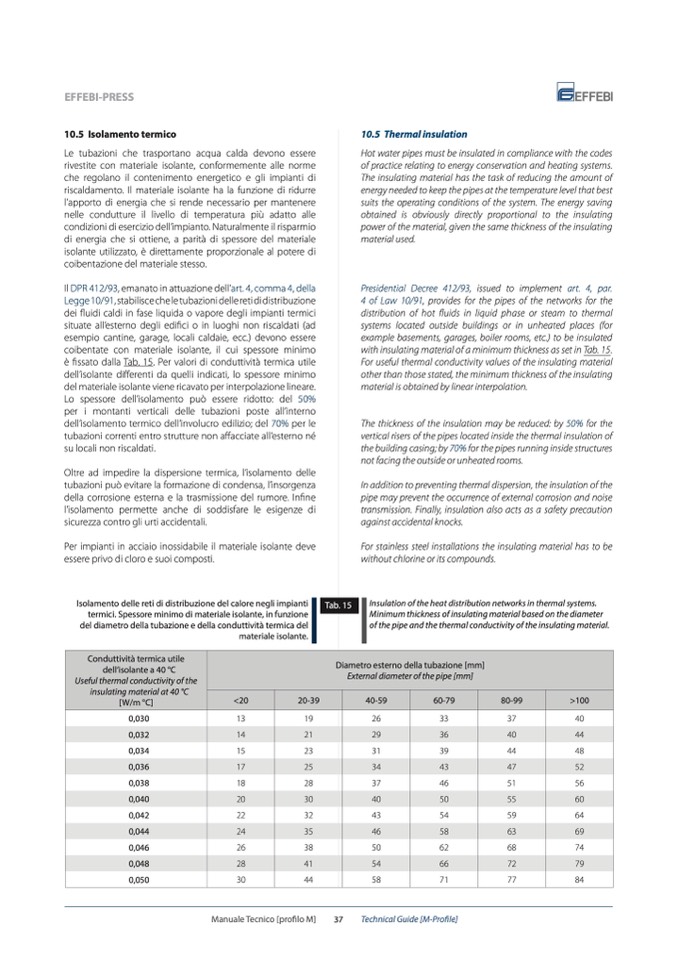
EFFEBI-PRESS
10.5 Isolamento termico
Le tubazioni che trasportano acqua calda devono essere
rivestite con materiale isolante, conformemente alle norme
che regolano il contenimento energetico e gli impianti di
riscaldamento. Il materiale isolante ha la funzione di ridurre
l’apporto di energia che si rende necessario per mantenere
nelle condutture il livello di temperatura più adatto alle
condizioni di esercizio dell’impianto. Naturalmente il risparmio
di energia che si ottiene, a parità di spessore del materiale
isolante utilizzato, è direttamente proporzionale al potere di
coibentazione del materiale stesso.
Il DPR 412/93, emanato in attuazione dell’art. 4, comma 4, della
Legge 10/91, stabilisce che le tubazioni delle reti di distribuzione
dei fluidi caldi in fase liquida o vapore degli impianti termici
situate all’esterno degli edifici o in luoghi non riscaldati (ad
esempio cantine, garage, locali caldaie, ecc.) devono essere
coibentate con materiale isolante, il cui spessore minimo
è fissato dalla Tab. 15. Per valori di conduttività termica utile
dell’isolante differenti da quelli indicati, lo spessore minimo
del materiale isolante viene ricavato per interpolazione lineare.
Lo spessore dell’isolamento può essere ridotto: del 50%
per i montanti verticali delle tubazioni poste all’interno
dell’isolamento termico dell’involucro edilizio; del 70% per le
tubazioni correnti entro strutture non affacciate all’esterno né
su locali non riscaldati.
Oltre ad impedire la dispersione termica, l’isolamento delle
tubazioni può evitare la formazione di condensa, l’insorgenza
della corrosione esterna e la trasmissione del rumore. Infine
l’isolamento permette anche di soddisfare le esigenze di
sicurezza contro gli urti accidentali.
Per impianti in acciaio inossidabile il materiale isolante deve
essere privo di cloro e suoi composti.
Isolamento delle reti di distribuzione del calore negli impianti
termici. Spessore minimo di materiale isolante, in funzione
del diametro della tubazione e della conduttivit
à termica del
materiale isolante.
Tab. 15
10.5 Thermal insulation
Hot water pipes must be insulated in compliance with the codes
of practice relating to energy conservation and heating systems.
The insulating material has the task of reducing the amount of
energy needed to keep the pipes at the temperature level that best
suits the operating conditions of the system. The energy saving
obtained is obviously directly proportional to the insulating
power of the material, given the same thickness of the insulating
material used.
Presidential Decree 412/93, issued to implement art. 4, par.
4 of Law 10/91, provides for the pipes of the networks for the
distribution of hot fluids in liquid phase or steam to thermal
systems located outside buildings or in unheated places (for
example basements, garages, boiler rooms, etc.) to be insulated
with insulating material of a minimum thickness as set in Tab. 15.
For useful thermal conductivity values of the insulating material
other than those stated, the minimum thickness of the insulating
material is obtained by linear interpolation.
The thickness of the insulation may be reduced: by 50% for the
vertical risers of the pipes located inside the thermal insulation of
the building casing; by 70% for the pipes running inside structures
not facing the outside or unheated rooms.
In addition to preventing thermal dispersion, the insulation of the
pipe may prevent the occurrence of external corrosion and noise
transmission. Finally, insulation also acts as a safety precaution
against accidental knocks.
For stainless steel installations the insulating material has to be
without chlorine or its compounds.
Insulation of the heat distribution networks in thermal systems.
Minimum thickness of insulating material based on the diameter
of the pipe and the thermal conductivity of the insulating material.
Conduttività termica utile
dell’isolante a 40 °C
Useful thermal conductivity of the
insulating material at 40 °C
[W/m °C]
Diametro esterno della tubazione [mm]
External diameter of the pipe [mm]
<20
20-39
40-59
60-79
80-99
>100
0,030
13
19
26
33
37
40
0,032
14
21
29
36
40
44
0,034
15
23
31
39
44
48
0,036
17
25
34
43
47
52
0,038
18
28
37
46
51
56
0,040
20
30
40
50
55
60
0,042
22
32
43
54
59
64
0,044
24
35
46
58
63
69
0,046
26
38
50
62
68
74
0,048
28
41
54
66
72
79
0,050
30
44
58
71
77
84
Manuale Tecnico [profilo M]
37
Technical Guide [M-Profile]

